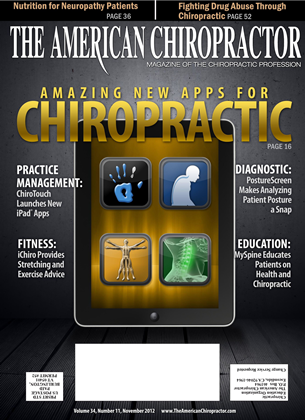As a chiropractor I use lumbar braces on my patients a great deal. I experience wonderful success in my therapeutic results as well as very strong financial rc-imbursement. especially from Medicare. I believe that every chiropractor should be a certified DME provider for Medicare: it just makes good sense. In the use of good quality lumbar bracing that is approved by Medicare (the only ones I will use) it is important to document in the patient's chart why the brace is given and its effectiveness. A physician must and should expect good results and the chart should reflect those results. I happen to like using functional testing to establish the need for and the effectiveness of any procedure I deliver. This is especially tnic in lumbar bracing. The "Get up and Go" test delivers on both points. This test paints a picture of the patient's functional status (forcxamplc: stability) that medical reviewers or even laymen can understand. There arc mam other ways to document but this particular test is especially effective. In the Journal of Rehabilitation, Research, & Development' the authors. James C. Wall. Phd. et al.. explain at length "The Timed Get up and Go Test." Other great sources arc an article in the Journal of American Geriatric Society-, written by authors Podsiadlo and Richardson, as well as an article in the Arch Phys \led Rehabilitation', courtesy of authors Mathias. Nayak. and Isaacs. For the purposes of a chiropractor or therapist testing a patient here is how the test is conducted: 1. The patient is sitting. 2. The doctor/attendant instructs the patient in how to perform the "get up and go" task. 3. The doctor/attendant observes the patient performing the "get up and go" task, noting the time in seconds it takes the patient to complete the task. He/she also observes other various points such as antalgia. gait, posture, stability, or others that mav be observed. The total time it takes a patient to perform the task should be 10 seconds or less. Any time over that is abnormal, with anytime over 20 seconds being very significant. Here arc the instructions to the patient on how to perform the tasks of the "get up and go" test. With the patient sitting in a chair, they are instructed to (when told to start) stand up on their own without using the ami rests. If they have to use the arm rest, note that in the chart. Once up they arc to then walk about 10 steps, stop, turn around, and walk back to the chair. Once back at the chair they arc to sit again. The test is over once they get to a comfortable, steady point when sitting. During the test I look for lots of indications of an impaired patient, such as muscle weakness, balance issues, heel/toe walking, cadence, hip swing, and all the other nuances that you may observe. If the patient takes 10-20 seconds to finish the "get up and go" task, this is considered abnormal. I find this a great deal in my patient mix. Patients that take over 20 seconds reflect a significant impairment functionally and need serious attention. I see this often as well. The next step I take in my office brings this test to another level. If I feel that stabilizing the patient's core or lumbopclvic spinal axis would be helpful. I fit the patient with a LSO (lum-bosacral orthotic) and do the test again. Immediate improvement in performing the "get up and go" test in a shortened time or stabilizing other factors proves to me the need for the brace. During the course of treatment I periodically check the patient's performance level of the test. I usually sec the time diminish, often to normal levels. At that point, using a small activity belt support such as a L0627 (one of the mam levels of belt classifications) might be all that is needed. This is just one way a physician or therapist can chart effectiveness and medical necessity, as well as the progress and compliance of the patient, when using a DME brace in the patient care plan. Braces can be very effective in stabilizing a patient in danger of exacerbation or falling. Some braces actually help increase the strength of muscles. Certainly braces can be a wonderful part of a care plan for a spinal patient. I want to do the very best for my patients. And I know you do too. Consider functional testing, such as the "Get up and Go" test in your overall assessment and documentation of a spine-compromised patient. You wont be disappointed and your results will improve. Reference: 1. Wall JC. Bell C. Campbell S. Davis J. The Timed Get-up and go Test Revisited: Measurement of the Component Tasks. Journal of Rehabilitation Research & Development. 2000 Jan:37(l): 109-114. 2. Podiadlo D. Richardson S. The Timed 'Up and Go" Test: A Test of Basic Functional Mobility for Frail Elderly Persons. Journal of American Geriatric Society. 1991: 39:142-148. 3. Mathias S. Nayak USL. Isaacs B. Balance in Elderly Patcints: the "Get Up and Go" Test. Arch Phys Mcd Rchabil. 1986:67:387-389. James C. Antos D.C.. DABCO. Dr. Antos has been in private chiropractic practice for 34 years. He is a a lecturer for Florida Stale License renewal on behalf of the Florida Chiropractic Association in the years of 2011 and 2012, teaching the the topic"DME and Lumbar Bracing". He can be reached by phone at 3H6-212-0007, or visit his website at www.antosdmebrace.com
 View Full Issue
View Full Issue






